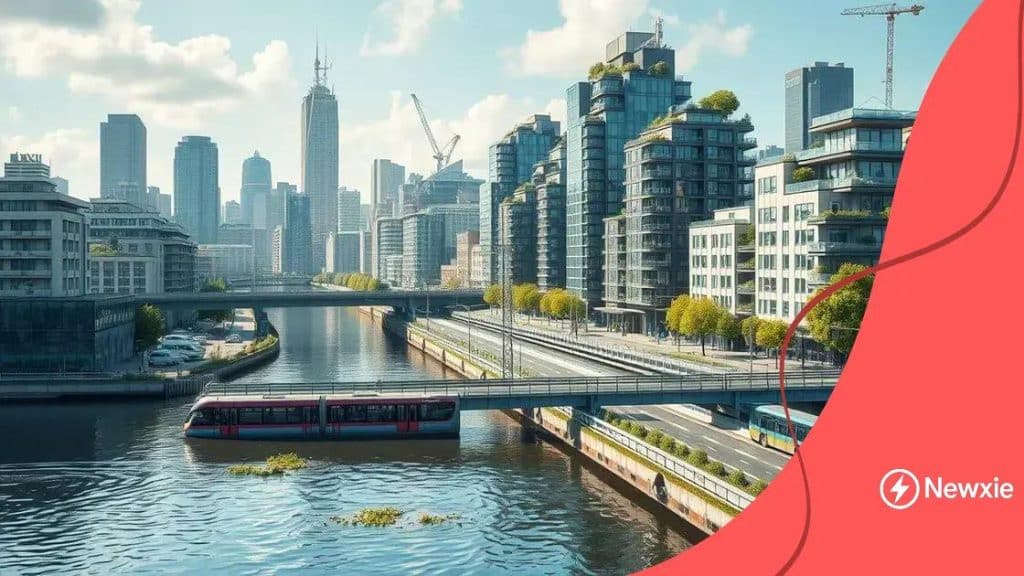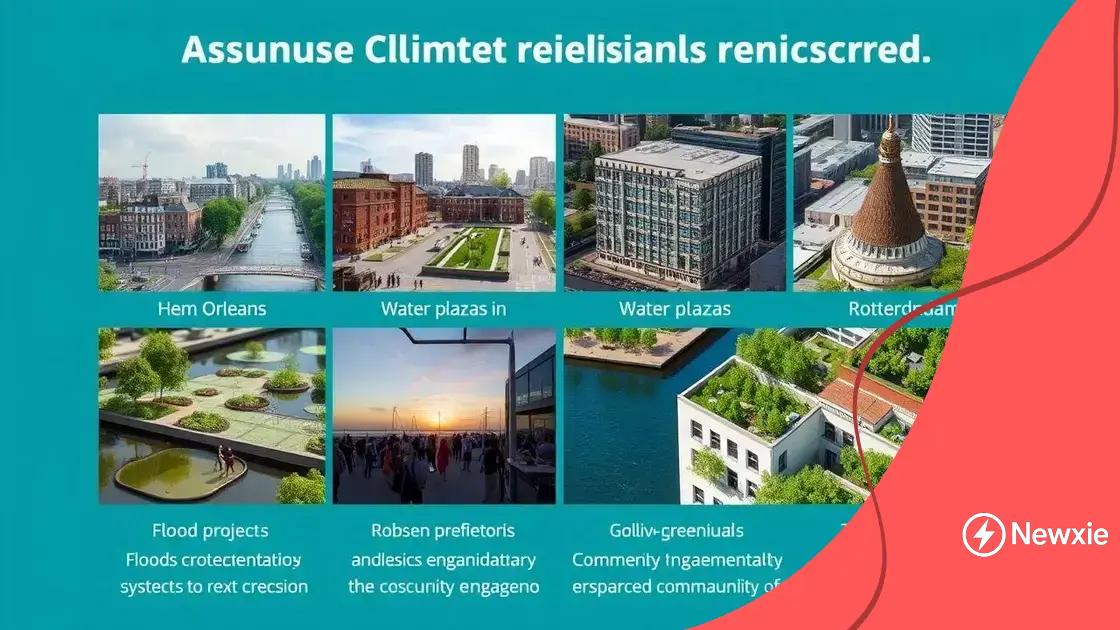Infrastructure projects focused on climate resilience are vital

Anúncios
Infrastructure projects focused on climate resilience aim to create systems that can withstand and adapt to climate change, incorporating renewable energy, smart technology, and community engagement for sustainable development.
Infrastructure projects focused on climate resilience play a crucial role in safeguarding our communities from climate change. Have you ever wondered how cities can adapt to rising sea levels or extreme weather events? Let’s explore the importance of these initiatives in modern infrastructure.
Understanding climate resilience in infrastructure
Anúncios
Understanding climate resilience in infrastructure is vital for our future. It helps communities withstand and recover from climate-related challenges.
What is climate resilience?
Climate resilience refers to the ability of a system to adapt to changing climate conditions. Resilient infrastructure can absorb shocks and continue functioning, even during extreme weather events.
Key characteristics of resilient infrastructure
- Durability against natural disasters.
- Flexibility to adapt to new conditions.
- Efficiency in resource use.
- Integration of natural solutions.
These characteristics ensure that infrastructure not only survives but thrives amid climate challenges. For example, roads designed to handle flooding can reduce damage during heavy rains.
It’s also important to engage communities in planning and decision-making. When local voices contribute, we create solutions that fit their unique challenges and needs.
Anúncios
The role of technology
Technology plays a crucial role in enhancing climate resilience. Smart technologies can monitor environmental changes, allowing for quick adaptations. Moreover, renewable energy sources contribute to sustainable infrastructure, reducing overall vulnerability.
Incorporating green spaces and natural barriers can help manage stormwater effectively, illustrating how nature can work as an ally in resilience efforts. This approach not only helps the environment but also improves community well-being.
Investing in climate-resilient projects is not just a necessity; it’s a strategy for sustainable growth. As we look toward the future, cities that prioritize climate resilience will be better prepared for the challenges ahead.
Key benefits of resilient infrastructure projects
The key benefits of resilient infrastructure projects are vital for communities facing climate change. These projects not only protect assets but also improve the quality of life for residents.
Enhanced safety and protection
Resilient infrastructure significantly reduces the risk of damage during extreme weather events. For instance, buildings designed to withstand floods or earthquakes ensure that inhabitants are safer.
Cost-effectiveness in the long run
Investing in robust infrastructure saves money over time. Although initial costs may be higher, the resulting durability reduces maintenance and repair expenses significantly. Here are a few ways in which this savings manifests:
- Lower repair costs after disasters.
- Reduced insurance premiums for safer structures.
- Extended lifespan of facilities.
- Increased property values in resilient areas.
This financial advantage means that resilient projects are not just a smart choice, they’re also a strategic one.
Moreover, such projects can create job opportunities during construction and maintenance phases. Local workers engaged in these initiatives contribute to the economy while gaining skills that are valuable for future employment.
Environmental benefits
Investing in resilient infrastructure leads to improved environmental health. For example, using green building materials reduces carbon footprints and promotes sustainability. Incorporating features like green roofs and permeable pavements can enhance urban biodiversity, helping cities adapt to changing climates while preserving ecosystems.
Furthermore, these projects often prioritize renewable energy sources, which reduce reliance on fossil fuels. This shift not only supports sustainability but also drives innovation in energy technology.
Examples of successful climate resilience projects

Examples of successful climate resilience projects demonstrate how communities can adapt to climate change effectively. These projects vary widely, showcasing innovative solutions tailored to local challenges.
New Orleans’ flood protection system
After Hurricane Katrina, New Orleans invested heavily in a modern flood protection system. This infrastructure includes levees, pump stations, and floodgates that protect the city from storm surges and heavy rainfall. The emphasis on engineering improvements helps ensure that the community remains safe.
Rotterdam’s water plazas
In Rotterdam, the city has created innovative water plazas, which are public spaces designed to manage excess rainwater. These plazas act as parks during dry weather and as temporary water storage during storms. This dual purpose enhances community engagement while promoting sustainable water management.
- Reduces urban flooding during storms.
- Encourages community use and outdoor activities.
- Enhances urban aesthetics with green spaces.
Such projects highlight how urban design can contribute to climate resilience.
Tokyo’s green roofs initiative
Tokyo has launched initiatives to increase green roofs on buildings throughout the city. These green spaces provide insulation, absorb rainwater, and reduce the urban heat island effect. By encouraging plants on rooftops, the city enhances biodiversity and improves air quality.
These examples show that climate resilience is achievable through planning and investment. By learning from these successful projects, other cities can implement similar strategies to address their own unique challenges.
Challenges in implementing climate-resilient infrastructure
Implementing climate-resilient infrastructure comes with significant challenges. These obstacles can slow progress and increase project costs if not addressed properly.
Financial constraints
One major challenge is funding. Many governments face budget limitations that restrict their ability to invest in necessary infrastructure upgrades. Without adequate financial support, projects may not proceed or may be poorly executed. Funding sources can include:
- Government grants and loans.
- Private investments.
- Public-private partnerships.
- International aid for developing areas.
Securing these funding options is critical for successful projects.
Technical knowledge and expertise
Another hurdle is the need for specialized knowledge. Designing and implementing climate-resilient projects requires expertise in various fields such as engineering, environmental science, and urban planning. Communities often lack the necessary skills or training, which can hinder project development. Educating local professionals can bridge this gap and enhance project outcomes.
Moreover, local governments may encounter difficulties in integrating new technologies with existing infrastructure. Upgrading old systems to be climate-resilient can be complex, necessitating collaboration among multiple stakeholders.
Community engagement and support
Engaging the community is essential but can be difficult. Residents must understand the importance of climate resilience to support these infrastructure changes. Misunderstandings or skepticism can lead to opposition, delaying or derailing projects. Effective communication strategies are crucial to inform and involve the public.
Ultimately, addressing these challenges requires a collaborative effort. By bringing together governments, experts, and communities, we can pave the way for successful implementation of climate-resilient infrastructure.
Future trends in climate-focused infrastructure development
Future trends in climate-focused infrastructure development are essential for adapting to a changing world. As climate change impacts become more evident, building resilient systems will be a priority for urban planners and governments.
Increased use of renewable energy
One notable trend is the shift towards renewable energy sources. Solar and wind power are becoming integral to new infrastructure projects. By harnessing clean energy, cities can reduce their carbon footprint while ensuring sustainability.
Smart technology integration
Another important trend is the integration of smart technologies in infrastructure. Smart sensors and data analytics allow cities to monitor environmental conditions and optimize resource use. This leads to enhanced efficiency and lower operational costs.
For example, smart grids can dynamically manage energy distribution based on demand, while smart traffic systems improve urban mobility, easing congestion and reducing emissions.
Focus on green building practices
Green building practices are increasingly popular as well. These methods prioritize using sustainable materials, improving energy efficiency, and minimizing waste. Notable practices include:
- Utilizing recycled materials.
- Implementing energy-efficient systems.
- Designing buildings for natural lighting and ventilation.
- Creating green roofs and walls.
By adopting these practices, communities can create healthier living environments while addressing climate challenges.
Community-driven projects
Community engagement will be key in shaping future infrastructure. Involving residents in the planning process ensures that projects meet their needs. This participatory approach can lead to more effective outcomes and greater public support.
As urban centers evolve, there is a strong focus on creating inclusive spaces that benefit all community members. This aligns with the goals of social equity and environmental justice.
In summary, the future of climate-focused infrastructure development is bright, driven by innovation and community involvement. By embracing these trends, we can build a more resilient and sustainable world for future generations.
In conclusion, the future of climate-focused infrastructure development is crucial for building resilient communities. By embracing renewable energy, smart technology, and sustainable practices, we can create effective solutions for today’s challenges. Community involvement also plays a vital role in shaping these projects, ensuring they meet local needs. Together, we can pave the way for a sustainable and brighter future.
FAQ – Frequently Asked Questions about Climate-Resilient Infrastructure
What is climate-resilient infrastructure?
Climate-resilient infrastructure refers to systems and structures designed to withstand and adapt to climate change impacts, ensuring safety and functionality.
Why is renewable energy important for future projects?
Renewable energy reduces reliance on fossil fuels, lowers greenhouse gas emissions, and promotes sustainability in infrastructure development.
How can smart technology enhance infrastructure resilience?
Smart technology allows for real-time monitoring and data analysis, leading to improved resource management and quicker responses to environmental changes.
What role does community engagement play in infrastructure projects?
Community engagement ensures that local needs are met and fosters greater support for projects, leading to better outcomes and positive impacts.
SEE MORE CONTENT




